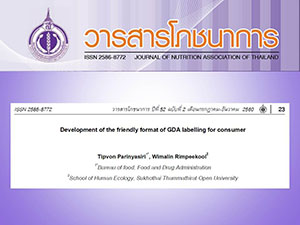Development of the friendly format of GDA labelling for consumer
Keywords:
GDA labelling, per package, per servingAbstract
Overnutrition, which is one of causes of non-communicable diseases, has dramatically increased severity. To response to this issue, therefore, Food and Drug Administration had developed the Guideline Daily Amounts (GDAs) labelling to be used as guidance for consumer to choose foods wisely. In 2011, the Ministry of Public Health (MOPH) Notification regarding provision of GDA labelling came into force and applied to snack. After that, the MOPH Notification No.374 of B.E.2559 has been enforced since 2016 to which covers 5 types of foods. The objectives of this study were to survey on consumers’ behavior and attitude on using of GDA labelling; and to evaluate the format of GDA labelling with respect to its applicable. The survey was conducted between 5 May to 2 June 2017 using an online questionnaire platform. The 560 respondents were obtained. Among these, 49.9% replied frequent using the nutrition labels of both standard type and GDAs type. Furthermore, the respondents reflected their enthusiasm of reading nutrition information displayed on the label of products that are not covered under the mandatory nutrition labelling regulations such as beverage products and ready-to-eat tea in liquid form. Knowledge and understanding of nutrition information was evaluated toward choices of unit of nutrient contents and it was revealed that the most of respondents correctly interpreted the nutrition information that displayed as “per package” unit, whereas there were significant (p< 0.05) lesser numbers of respondents who interpreted “per serving” unit correctly. Regarding application of the GDAs-type versus the standard-type of nutrition labeling, 64.7% of respondents favored the GDAs-type and more than 50% favored displaying the GDAs-type with “per package” unit on the food products contained in large containers as this could help consumer to aware on food consumption.
References
2. สถาบันวิจัยประชากรและสังคม. สุขภาพคนไทย 2559. กรุงเทพฯ: อมรินทร์พริ้นติ้งแอนด์พับลิชชิ่ง; 2559.
3. สำนักอาหาร กระทรวงสาธารณสุข. การสำรวจสถานการณ์การแสดงข้อมูลโภชนาการในผลิตภัณฑ์อาหารสำเร็จรูปที่พร้อมบริโภคทันทีปี 2557. นนทบุรี: สำนักอาหาร กระทรวงสาธารณสุข; 2557.
4. สำนักอาหาร กระทรวงสาธารณสุข. การสำรวจสถานการณ์การใช้ฉลากโภชนาการแบบ GDA ของประเทศไทย (National survey) 2557. นนทบุรี: สำนักอาหาร กระทรวงสาธารณสุข; 2557.
5. Cochran WG. Sampling techniques. New York, NY: John Wiley & Sons; 1977.
6. Guthrie JF, Fox JJ, Cleveland LE, Welsh S. Who uses nutrition labeling, and what effects does label use have on diet quality? Journal of Nutrition Education. 1995;27(4):163-72.
7. Smith SC, Taylor JG, Stephen AM. Use of food labels and beliefs about diet–disease relationships among university students. Public Health Nutr. 2000;3(2):175-82.
8. Stran KA, Knol LL. Determinants of food label use differ by sex. J Acad Nutr Diet. 2013;113(5):673-9.
9. Wardle J, Haase A, Steptoe A, Nillapun M, Jonwutiwes K, Bellisie F. Gender differences in food choice: the contribution of health beliefs and dieting. Ann Behav Med. 2004;27(2):107-16.

Downloads
Published
How to Cite
Issue
Section
License
Upon acceptance of an article, copyright is belonging to the Nutrition Association of Thailand.


